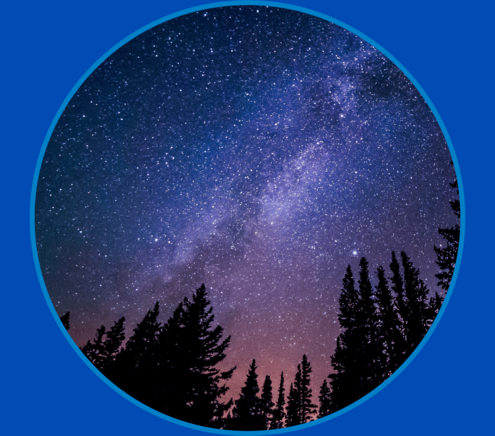A Kid's Guide to
Stargazing

The night sky is like a giant puzzle. Hidden among the thousands of stars you can find dozens of constellations. You can also search for individual stars and planets.
Stargazing Do's & Don'ts
Go out in the right conditions.
Stargaze when there is little or no moonlight and the sky isn’t cloudy. Find an area away from street lamps, neon signs, and headlights. And give your eyes a half hour to adjust to the darkness.
Bring some stargazing tools.
Bring a sky map to help you identify what you see. With a good star map, there’s no limit to what you can find!
Borrow binoculars or a telescope to see these celestial sights more clearly and closer up.
Keep a notebook with you to sketch what you see in the sky and to keep a record of your sightings. Before you know it, you’ll have a long list of discoveries.
Bring a flashlight to help you find your way and to see your notebook, compass or sky map.
Stay safe!
Bring a friend or parent along to help search the night sky. Don’t ever go out at night without your parents’ permission.
Don’t wander around. It’s easy to get lost, so keep track of where you are. Remember to hold your notebook so your mark for north always points north.
Is It a Star?

Not all points of light you see at night are stars. Airplanes, satellites, and meteors (or “shooting stars”) move fast, so they’re easy to tell from stars. But what about planets?
Planets look a lot like bright stars, so telling stars from planets can be tricky. One clue is that planets don't twinkle like stars, although it's sometimes hard to see the difference. To see what planets are currently visible in the night sky, go to: Timeanddate.com's Interactive Night Sky Map.
To see what constellations are in the sky for the current month, check out NASA's Printable Star Maps Activity.
Keeping Your Sky Journal
All you need are a notebook, pencil, flashlight, and compass. Here are some tips:

1. Use a pencil. This will make it easier to move a star!
2. Draw a circle that’s at least 12 centimeters (5 inches) across in your journal. This will represent the horizon on all sides.
3. Figure out which way is north using your compass. Mark it on the edge of the circle.
4. Draw in some landmarks you see at the horizon, such as trees and buildings. This will help you keep track of which way you’re looking. It will also help you compare observations from different days.
5. Look straight up. Record what you see in the middle of the circle. Use little circles or dots to show the stars.
6. Make a note of the date, time, and who made the observations with you. Later, this information will help you identify what you saw.
7. Also note the weather conditions, the place, and any notes about what the sky looked like.
What to Look for
What you’ll see depends on where you are, the time of the year, and the weather. If you are in a populated area, “light pollution” might make it hard to see all but the brightest stars. To get you started, here are some things to look for:
Why Can’t I See More Stars?

In many places, especially cities, “light pollution” floods the atmosphere. This makes it impossible for us to see the light from distant stars. If there is too much light pollution where you live, visit a nearby planetarium or the Astronomy Picture of the Day.

Image Credits:
starfield background, ©AMNH; Stargazing kids, ©AMNH; Girls stargazing, by Greg Rakozy on Unsplash; Sky Journal, ©AMNH; Pencil, Joanna Kosinska on Unsplash; North Star, ©AMNH; Milky way, ©Ryan Hutton/Unsplash; Moon phases, ©AMNH; Moon illustration by Vecteezy; Constellation of Orion, ©AMNH; Cassiopeia, ©AMNH; Girl scratching head, ©AMNH; Cityscape, ©AMNH.




 Biodiversity
Biodiversity
 Brain
Brain
 Genetics
Genetics
 Marine BiOLogy
Marine BiOLogy
 MicrobiOLogy
MicrobiOLogy
 PaleontOLogy
PaleontOLogy
 ZoOLogy
ZoOLogy
 AnthropOLogy
AnthropOLogy
 ArchaeOLogy
ArchaeOLogy
 Astronomy
Astronomy
 Climate Change
Climate Change
 Earth
Earth
 Physics
Physics
 Water
Water





